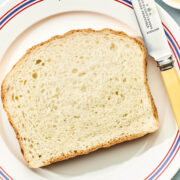Homemade White Bread
Homemade white bread is soft, easy to slice, and perfect for sandwiches or toast. A simple yeast dough with minimal ingredients.
Servings: 12 servings
Calories: 142kcal
Equipment
- Measuring cups and spoons or digital kitchen scale
- Mixing bowl
- Danish dough whisk (optional) or sturdy spoon
- Clean shower cap or tea towel
- Two 9 x 5-inch (23 x 13 cm) standard loaf pans (see recipe notes)
- Pastry brush
- Wire rack
Ingredients
- 1 ¼ cups warm water 100°F to 110°F (38°C to 43°C), divided
- 1 ¼ teaspoons active dry yeast not rapid rise
- 1 tablespoon granulated sugar divided
- 1 teaspoon table salt
- 2 tablespoons salted butter melted, divided
- 3 cups all-purpose flour plus up to ¼ cup (38 g) extra for kneading
Instructions
- Pour ¼ cup (63 g) of the warm water into a mixing bowl. Add the yeast and ½ teaspoon of the sugar. Stir to combine, and let sit for 10 minutes until the yeast is frothy and expanded.
- Add the remaining 1 cup (250 g) of warm water, the rest of the sugar (2 ½ teaspoons), 1 tablespoon of melted butter, and the salt. Stir to combine.
- Add the flour and stir until a shaggy dough forms, making sure all the flour is incorporated.
- Turn the dough onto a lightly floured surface. Knead by hand for 10 minutes, adding a sprinkle of flour whenever the dough sticks to the work surface or your hands. Continue kneading until the dough is smooth, elastic, and slightly tacky but not sticky.
- Shape the dough into a ball and place it back in the mixing bowl. Cover with a shower cap, lid, or damp tea towel, and let rise in a draft-free place for about 1 hour or until doubled in size.
- Line a 9 x 5-inch (23 x 13 cm) standard loaf pan with parchment paper and set aside.
- Gently punch down the dough, turn it onto a work surface, and divide it in two. Shape each piece into a smooth ball, sealing the seams. Place one dough ball at each end of the loaf pan, cover, and let it rise until it's 1 inch (3 cm) above the rim of the pan, about 1 hour.
- Preheat the oven to 425°F (220°C). Melt the remaining tablespoon of butter and brush it over the dough. Place a second loaf pan upside down over the top of the dough to create a cover. Bake the bread for 20 minutes, then carefully remove the top pan and continue baking for another 10 to 15 minutes. The loaf is done when the top is golden brown and sounds hollow when tapped.
- Remove the loaf from the pan and transfer it to a wire rack. Cool completely before slicing.
Notes
- Yeast loses its potency over time, so always check the expiration date. If your yeast doesn’t foam after sitting in warm water with sugar for 10 minutes, it may be inactive and should be replaced.
- Rising times can vary based on kitchen temperature, water temperature, and humidity. Instead of relying on the clock, look for the dough to double in size during the first rise and rise about 1 inch (3 cm) above the pan’s rim during the second rise.
- If you don’t have a second loaf pan to use as a cover, you can lightly tent the bread with foil or bake it uncovered.
Storage
- Store the cooled bread in an airtight container or bag at room temperature for up to 2 days. For longer storage, slice and freeze the cooled bread in a zipper-top bag. Thaw at room temperature or toast before serving.
Nutrition
Serving: 1serving | Calories: 142kcal | Carbohydrates: 26g | Protein: 4g | Fat: 2g | Saturated Fat: 1g | Polyunsaturated Fat: 0.2g | Monounsaturated Fat: 1g | Trans Fat: 0.1g | Cholesterol: 5mg | Sodium: 211mg | Potassium: 39mg | Fiber: 1g | Sugar: 1g | Vitamin A: 58IU | Vitamin C: 0.001mg | Calcium: 7mg | Iron: 2mg
